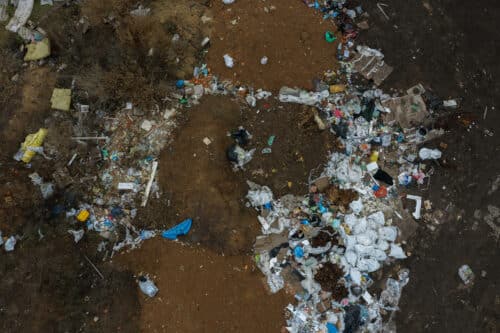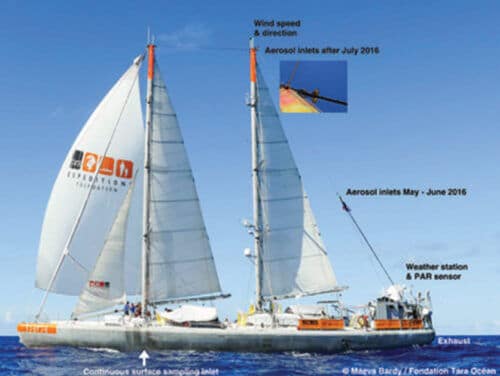Prof. Ilan Koren: "Even if we stop polluting the beaches tomorrow morning, we are expected to see more and more microplastic particles emitted into the atmosphere - since it takes time for the plastic waste that has already found its way to the sea to break down into particles"

Although plastic products thrown into the sea are not biodegradable, they gradually disintegrate and turn into microplastic particles that can be a serious ecological problem that endangers not only the marine environment but also human health. Weizmann Institute of Science scientists recently found out Because these particles drift to remote corners of the ocean - those that were considered clear and free from the harmful effects of man - and can be emitted into the atmosphere and remain in the air for long hours and even days.
"Previous studies have already shown the presence of microplastics in the atmosphere in the areas near the coastline," says Dr. Miri Trinik from the research groups of Prof. Ilan Koren from the Department of Earth and Planetary Sciences and Prof. Assaf Verdi From the Department of Plant and Environmental Sciences. "However, we were amazed to discover a significant amount of microplastics above parts of the ocean that are supposedly 'pristine'."
The research groups of Professors Verdi and Korn - together with Prof. Yanon Rodich from the Department of Earth and Planetary Sciences - have been collaborating for years in an attempt to understand the interface between the ocean and the atmosphere. As part of these research efforts, In 2016, Dr. Mitchell Flores was sent on the voyage of the research ship "Tara" in the North Atlantic Ocean and collected, among other things, particle samples in the air above these remote areas of the ocean.

When the samples arrived at the Weizmann Institute of Science, the researchers realized that identifying the microplastics in the samples is far from easy. To understand precisely which types of plastic entered the atmosphere, the researchers turned to staff scientist Dr. Ido Pankas, an expert in a technique known as Raman spectroscopy in the Department of Chemical Research Infrastructures. With its help, the scientists discovered that the collected samples had high levels of several common types of plastic, including polystyrene, polyethylene and polypropylene. From a calculation made by the scientists - which took into account the shape of the particles, their mass, the direction of the winds over the ocean and their speed - it emerged that the origin of the microplastic in the samples is apparently in the plastic bags and other plastic waste that is thrown on the beaches and makes its way hundreds of kilometers away - to the heart of the ocean.
The samples of the sea water in those areas revealed a similar composition of plastic particles. This fact strengthens the hypothesis that the microplastic particles entered the atmosphere as a result of seawater spray or were carried by the wind and transported by air currents to distant parts of the ocean.
"When microplastic particles are in the air, they dry out, are exposed to UV radiation and have chemical interactions with various atmospheric components," says Dr. Trinick. "This means that the particles that find their way back to the ocean may be even more harmful or toxic to the marine creatures that swallow them." Prof. Verdi adds: "The plastic in the sea serves as a breeding ground for bacteria. When the particles are carried by the wind, they may be carriers of marine bacterial species, among them disease-causing organisms that may harm both marine creatures and humans."
The scientists estimate that the actual amount of microplastics above the oceans is much greater than revealed by the measurements, as their systems could not detect particles below a certain size. Particle size is crucial: not only are smaller particles likely to stay in the air longer, but the smaller they are, the more likely they are to be eaten (but not digested) by tiny marine creatures.
"And there is another important ecological aspect: like all airborne particles, microplastic particles actually become part of the material cycles in nature - for example, the carbon and oxygen cycles," says Prof. Koren and concludes with a pessimistic forecast: "Even if we stop polluting the beaches tomorrow morning, we are expected To see more and more micro-plastic particles being emitted into the atmosphere - because it takes time for the plastic waste that has already found its way to the sea to disintegrate into particles."
"Previous studies have already shown the presence of microplastics in the atmosphere in the areas near the coastline," says Dr. Miri Trinik from the research groups of Prof. Ilan Koren from the Department of Earth and Planetary Sciences and Prof. Assaf Verdi From the Department of Plant and Environmental Sciences. "However, we were amazed to discover a significant amount of microplastics above parts of the ocean that are supposedly 'pristine'."
The research groups of Professors Verdi and Korn - together with Prof. Yanon Rodich from the Department of Earth and Planetary Sciences - have been collaborating for years in an attempt to understand the interface between the ocean and the atmosphere. As part of these research efforts, In 2016, Dr. Mitchell Flores was sent on the voyage of the research ship "Tara" in the North Atlantic Ocean and collected, among other things, particle samples in the air above these remote areas of the ocean.
When the samples arrived at the Weizmann Institute of Science, the researchers realized that identifying the microplastics in the samples is far from easy. To understand precisely which types of plastic entered the atmosphere, the researchers turned to staff scientist Dr. Ido Pankas, an expert in a technique known as Raman spectroscopy in the Department of Chemical Research Infrastructures. With its help, the scientists discovered that the collected samples had high levels of several common types of plastic, including polystyrene, polyethylene and polypropylene. From a calculation made by the scientists - which took into account the shape of the particles, their mass, the direction of the winds over the ocean and their speed - it emerged that the origin of the microplastic in the samples is apparently in the plastic bags and other plastic waste that is thrown on the beaches and makes its way hundreds of kilometers away - to the heart of the ocean.
The samples of the sea water in those areas revealed a similar composition of plastic particles. This fact strengthens the hypothesis that the microplastic particles entered the atmosphere as a result of seawater spray or were carried by the wind and transported by air currents to distant parts of the ocean.
"When microplastic particles are in the air, they dry out, are exposed to UV radiation and have chemical interactions with various atmospheric components," says Dr. Trinick. "This means that the particles that find their way back to the ocean may be even more harmful or toxic to the marine creatures that swallow them." Prof. Verdi adds: "The plastic in the sea serves as a breeding ground for bacteria. When the particles are carried by the wind, they may be carriers of marine bacterial species, among them disease-causing organisms that may harm both marine creatures and humans."
The scientists estimate that the actual amount of microplastics above the oceans is much greater than revealed by the measurements, as their systems could not detect particles below a certain size. Particle size is crucial: not only are smaller particles likely to stay in the air longer, but the smaller they are, the more likely they are to be eaten (but not digested) by tiny marine creatures.
"And there is another important ecological aspect: like all airborne particles, microplastic particles actually become part of the material cycles in nature - for example, the carbon and oxygen cycles," says Prof. Koren and concludes with a pessimistic forecast: "Even if we stop polluting the beaches tomorrow morning, we are expected To see more and more micro-plastic particles being emitted into the atmosphere - because it takes time for the plastic waste that has already found its way to the sea to disintegrate into particles."
More of the topic in Hayadan:
